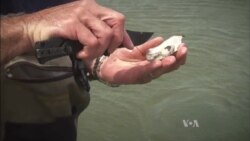The Blue Point oyster is returning to the Great South Bay of New York after almost disappearing from the world marketplace. Over-farming, pollution and Hurricane Sandy had severely damaged the Blue Point oyster business. Now, the population is growing in its home on the coast of Long Island, about 100 kilometers from New York City.
When the huge ocean storm called Sandy hit Long Island in 2013 it destroyed the Blue Point oyster beds. John Cochrane is a councilman in the Town of Islip.
“There was 15-foot [4.5 meter] seas hitting those beds. It took all the oysterman’s gear and oysters and ripped half of them away from their anchoring and the other half got slammed into the bay bottom and got destroyed.”
John Cochrane pushed through a legislative measure to lease 1,200 hectares of the Great South Bay to shellfish businesses. Twenty-three local fishermen, including the Cochrane family, have signed up so far.
“We have plots on this Bay that were actually leased out by King George, and families still have the charter in Brookhaven from King George.”
The Great Atlantic Shellfish Farms company will be a major part of regrowing the oyster population in the Great South Bay. Marty Byrnes is an aquaculturist with the company. He is responsible for getting adult oysters to spawn - lay eggs and produce the larvae that turn into millions of oysters.
“Inside here is where all the larvae go after they have been spawned. The eggs and sperm have mated and you actually have larvae swimming around here.”
Marty Byrnes grows the plant food of oysters, algae, in large tanks filled with salt water. The larvae absorb their algae diet for about two and a half weeks. Then, baby oysters appear.
“It looks like a grain of sand right now. It’s amazing, nature.”
After six weeks, millions upon millions of these little oysters are taken to farms in the bay. They are placed in wire boxes to grow to harvesting size. In 18 months, these oysters will be ready for market.
Doug Winter is president of Great Atlantic. He says the oyster business has come a long way from the bay bottom harvesting of the 1800s.
“With technology and advancements and the Internet and people really being environmentally conscious, there’s a big push for aquaculture. You can produce a lot more oysters, you can do it environmentally friendly, you can create reefs and clean estuaries, waterways, you can repopulate areas that are depleted and you can control your crop.”
The Blue Point is back. And the oysters are not just good to eat. They are also good to the water. Each oyster can filter more than 150 liters of water a day, removing algae, nitrogen, and other pollutants.
I’m Marsha James.
Bernard Shusman reported this story from East Islip, New York. Marsha James adapted it into Learning English. Caty Weaver was the editor.
______________________________________________________________
Words in This Story
bed – n. the ground that is at the bottom of a sea, lake, etc.
lease – v. to rent out a place in return for money
plot – n. an area of land that has been measured and is considered as a unit
spawn – v. to produce or lay eggs in water
larvae –n. a very young form of life
aquaculture – n. the rearing of water animals or the cultivation of water plants for food
estuary – n. an area where a river flows into the sea





